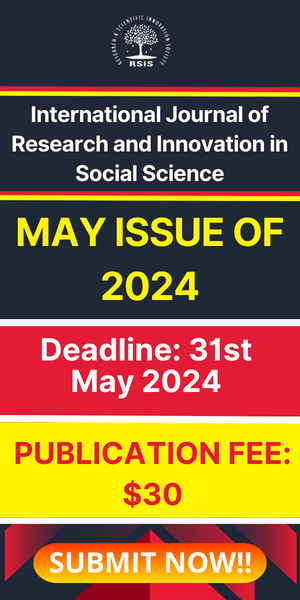- June 24, 2023
- Posted by: rsispostadmin
- Categories: IJRSI, Urban and Regional Planning
An analysis of the effects of urbanization on urban drainage systems in Ankpa, Dekina and Oguma Towns of Kogi State in North Central Nigeria
1Eyimoga, Helen Alikeju, 2Abraham Sunday Samuel (PhD)
1Department of Sciences, School of Preliminary Studies, Kogi State Polytechnic Lokoja,
2School of Environmental Technology, Department of Urban and Regional Studies, Kogi State Polytechnic, Lokoja.
DOI: https://doi.org/10.51244/IJRSI.2023.10515
Received: 03 May 2023; Revised: 20 May 2023; Accepted: 24 May 2023; Published: 24 June 2023
Abstract: Managing complex environmental problems such as flood disaster require up to date technology. Much of these disasters can be prevented and reduced through the use of technology such as Geographic Information Systems (GIS) and remote sensing as well as questionnaire administration. The spatial analytic capacity of GIS is employed to carryout hydrological analysis such as drainage network, DEM, Slope, flow direction and accumulation, stream order. Also land use and land cover analysis was done to examine the changes in land cover pattern across the study area. Different datasets were extracted from satellite imagery (landsat TM and OLI) of the Study area. ArcGIS 10.8 and Idrisi Terrset were used for the land cover change spatial analyses. The results from image analysis revealed that built-up area have been increasing significantly in the area due to increasing population pressure, it increases from 11.70%, 9.74% and 13.15% in 1990 to 18.12%, 16.05% and 19.37% in 2021 for Ankpa, Bassa and Oguma (Dekina) respectively. The flood risk vulnerability map reveals that about 15.44% (835.73 km2) and 15.81% (856.25 km2) of the study area have very high and high susceptibility to flooding inundation, respectively. The vulnerable zones are located on the lowest part of the plain which is responsible for the high flood vulnerability experienced in this area. It can be deduced that the magnitude of the flood hazard of a given area is a function of both the distance to the river and the elevation of the area in question. The result of the questionnaire analysis indicates that 67.55%,65.96% and 61.48% strongly agreed that shallow drainage channels in Ankpa, Dekina and Oguma are the major drainage challenges in the study area while 65.70%, 56.73% and 56.46%, strongly agree that several homes are destroyed when drainage fail and 56.20%, 63.32%, and 57.26% strongly agree that availability of social services is responsible for the increase population upsurge to urban centers. It is believed that the result of this research can be used as a means of regulating development along the plain and also serve as a decision support when making policies relating to drainage and flood management around urban centres.
Key words: urbanization, drainage systems, North Central, flood disaster
I. Introduction
A good proportion of the world population live in developing countries of Asia and Africa, mostly residing in horrible conditions in slums in major towns and cities including their suburbs. Poor drainage facilities are peculiar problem associated with this settlement types resulting in constant contact with contaminated water and flooding (WHO, 2006). According to the World Health Organisation (2006), drainage unfortunately wasn’t even one of the Millennium Development Goals (MDGs), even though an estimated 2.4 billion total of the world population does not have access to improved sanitation in 2015. Presently, about 2.6 billion people live without proper sanitation of which Africa is not exempted (Olukanni, 2013a); WHO/UNICEF, 2012).
Today, the agenda to make cities more sustainable and combat climate change has come on board as part of the Sustainable Development Goals (SUGs) of 2030. In the view of Geldof and Stahre (2006) the introduction of concept of sustainability has, in the field of urban water systems, among others led to an increase interest for source control and open drainage of storm water within the urban environment. This however creates the need to provide proper sanitation facilities to match up with the ever-increasing population growth (Banergee and Morella, 2011).


